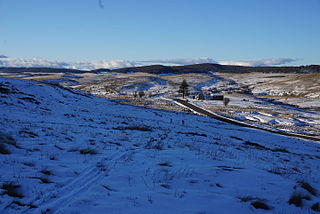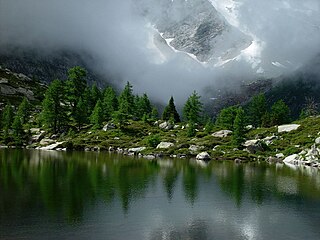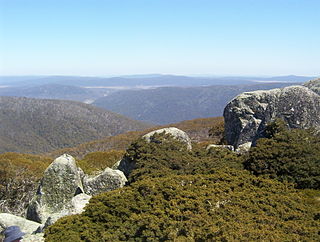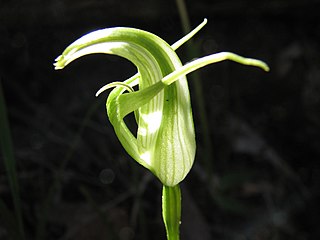
Pterostylis alpina, commonly known as the mountain greenhood, is a species of orchid endemic to south-eastern Australia. It has a rosette of fleshy leaves at the base and usually only one white flower with green markings and back-swept lateral sepals.

Pterostylis baptistii, commonly known as the king greenhood, is a species of orchid endemic to eastern Australia. Flowering plants have a rosette of stalked, dark green leaves and a single white flower with green and brown markings, and a wide gap between the petals and lateral sepals. It occurs mostly in New South Wales but is also found in coastal Queensland and north-eastern Victoria.
Pterostylis aenigma, commonly known as the enigmatic greenhood is a species of orchid endemic to Victoria. It has a rosette of leaves and a single green and white flower which leans forward and has a brownish point on the end. It is a rare orchid, occurring at only one site with fewer than 100 individual plants and is thought to be a natural hybrid between two species that grow nearby.

Pterostylis cucullata, commonly known as the leafy greenhood, is a plant in the orchid family Orchidaceae and is endemic to south-eastern Australia. It has a rosette of fleshy leaves at its base and a single white, green and reddish-brown flower.

Pterostylis monticola, commonly known as the large mountain greenhood, is a species of orchid endemic to south-eastern Australia. It has a rosette of fleshy leaves at the base of the plant and a single dark green and white flower. It grows in alpine and sub-alpine colonies.

Pterostylis scabrida, commonly known as the rough greenhood, is a species of orchid endemic to Tasmania. It has a rosette of leaves at the base of the plant and a single green and white flower on a rough stem. It is widespread and common in wet forests and is one of the few species of Pterostylis to grow in rainforest.

Pterostylis ventricosa is a recently described and critically endangered species of orchid endemic to a small area of New South Wales. As with similar orchids, the flowering plants differ from those which are not flowering. The non-flowering plants have a rosette of leaves but the flowering plants lack a rosette at the base but have up to six tiny green, white and brown flowers.

Pterostylis aneba is a species of orchid endemic to south-eastern Australia. It is a recently described and poorly-known greenhood similar to Pterostylis alpina and P. monticola. It has a rosette of fleshy leaves at the base of the plant and a single green and white flower. It grows in alpine and sub-alpine habitats.
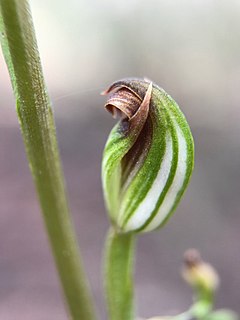
Pterostylis rubescens, commonly known as the blushing tiny greenhood, is a species of orchid endemic to south-eastern Australia. As with similar orchids, the flowering plants differ from those which are not flowering. The non-flowering plants have a rosette of leaves but the flowering plants lack a rosette at the base and have up to eighteen tiny green, white and brownish flowers.
Pterostylis bicornis, commonly known as the horned greenhood, is a plant in the orchid family Orchidaceae and is endemic to eastern Australia. Non-flowering plants have a rosette of leaves while flowering plants have a similar rosette at the base of a flowering spike with a one or two dark green, white and brown flowers. The flowers have distinctive long, thin horn-like tips.
Pterostylis dubia, commonly known as the blue-tongued greenhood, is a plant in the orchid family Orchidaceae and is endemic to Tasmania. It has a rosette of fleshy leaves at its base and a dark green and white flower with narrow petals and a dark blue-green labellum.

Pterostylis elegans, commonly known as the elegant greenhood, is a species of orchid endemic to New South Wales. Non-flowering plants have a rosette of leaves flat on the ground but flowering plants have a single translucent white and dark green flower with reddish-brown markings near the tip.

Pterostylis hildae, commonly known as the rainforest greenhood, is a species of orchid found in eastern Australia. It has a rosette of leaves and when flowering a rosette at the base of a flowering stem with a single green, white and brown flower. It is found in wet forests, including rainforest in New South Wales and Queensland.
Pterostylis paludosa, commonly known as swamp greenhood, is a species of greenhood orchid endemic to New Zealand. As with similar orchids, plants in flower differ from those that are not. Those not in flower have a rosette of leaves on a short stalk but plants in flower lack a rosette and have a single flower with leaves on the flowering spike. This greenhood has a translucent white flower with pale to yellowish-green stripes.
Pterostylis procera, commonly known as the short-lipped greenhood, is a species of orchid endemic to Queensland. It has a rosette of leaves and when flowering a single translucent white flower with green and reddish markings and a labellum which does not protrude through the lateral sepals.
Pterostylis riparia, commonly known as the streamside greenhood, is a plant in the orchid family Orchidaceae and is endemic to New South Wales. Both flowering and non-flowering plants have a rosette of dark green, fleshy leaves. Flowering plants have a single relatively large green, white and reddish-brown flower with a deeply notched sinus between hairy lateral sepals.
Pterostylis subtilis, commonly known as the thin mountain greenhood, is a species of orchid endemic to New South Wales. It has a rosette of leaves and when flowering a single translucent white flower with dark green lines, a narrow, deeply notched sinus between the lateral sepals and a curved, protruding labellum.

Pterostylis torquata, commonly known as the collared greenhood, is a species of orchid endemic to New South Wales. As with similar greenhoods, the flowering plants differ from those which are not flowering. The non-flowering plants have a rosette of leaves flat on the ground but the flowering plants have a single flower with leaves on the flowering stem. This greenhood has a white flower with dark green and dark brown markings, although in some areas, the flowers lack the brown markings. The sinus between the lateral sepals is platform-like.
Pterostylis uliginosa, commonly known as the marsh greenhood, is a species of orchid endemic to south-eastern Australia. As with similar orchids, the flowering plants differ from those which are not flowering. The non-flowering plants have a rosette of leaves but the flowering plants lack a rosette at the base but have up to three rosettes on lateral growths and up to seven small green and white flowers. This species only grows in wet places, usually where there is free water. There are usually only two or three flowers per plant, and only one or two are open at a time.
Pterostylis vernalis, commonly known as the spring tiny greenhood, is a species of orchid endemic to New South Wales. As with similar orchids, the flowering plants differ from those that are not currently flowering. Non-flowering plants have a rosette of leaves at the base. Flowering plants lack that rosette, but have one or two rosettes on lateral growths. The flowers are green, brown and white. This greenhood is only known from a small area near Nowra.







